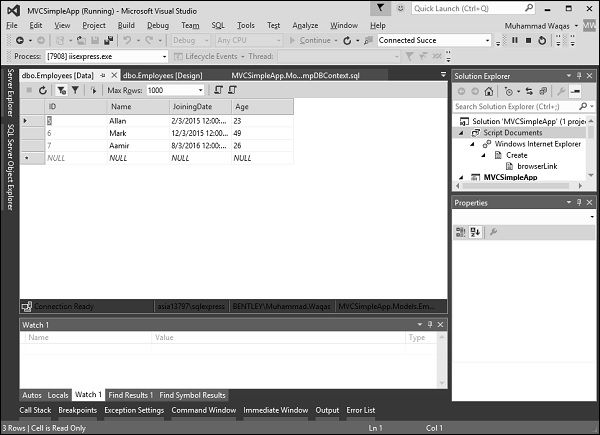ASP.NET MVC - 数据库
在本教程创建的所有 ASP.NET MVC 应用程序中,我们都将硬编码数据从控制器传递到视图模板。 但是,为了构建真正的 Web 应用程序,您可能需要使用真正的数据库。 在本章中,我们将了解如何使用数据库引擎来存储和检索应用程序所需的数据。
为了存储和检索数据,我们将使用称为实体框架(Entity Framework)的 .NET Framework 数据访问技术来定义和使用模型。
实体框架(Entity Framework) (EF) 支持代码优先技术,该技术允许您通过编写简单的类来创建模型对象,然后将从您的类动态创建数据库,从而实现非常干净且快速的开发工作流程。
让我们看一个简单的示例,我们将在示例中添加对实体框架(Entity Framework)的支持。
步骤 1 − 要安装实体框架(Entity Framework),请右键单击您的项目并选择 NuGet 包管理器 → 管理解决方案的 NuGet 包...
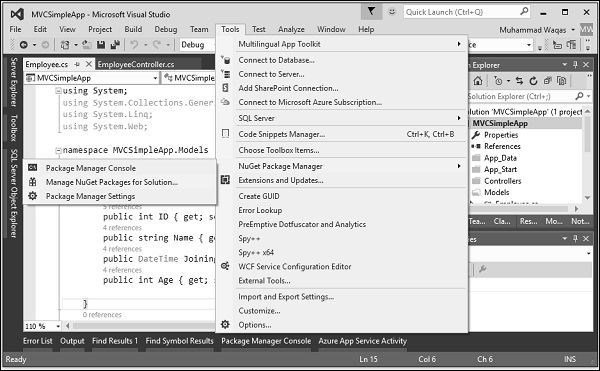
它将打开NuGet 包管理器。 在搜索框中搜索实体框架(Entity Framework)。
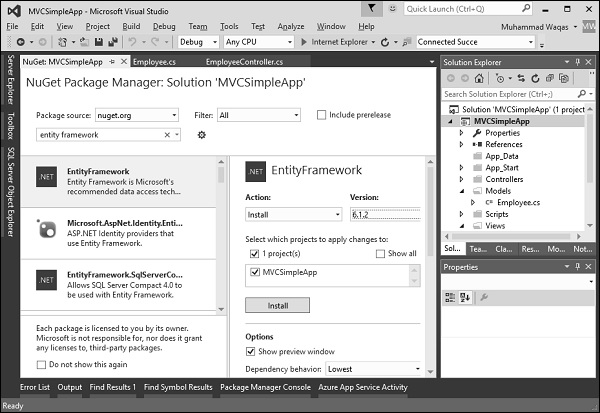
选择实体框架(Entity Framework)并单击"安装"按钮。 它将打开预览对话框。

单击"确定"继续。

单击"我接受"按钮开始安装。

安装实体框架(Entity Framework)后,您将在窗口中看到消息,如上面的屏幕截图所示。
添加数据库上下文
我们需要向员工模型添加另一个类,该类将使用以下代码与实体框架(Entity Framework)通信以检索和保存数据。
using System;
using System.Collections.Generic;
using System.Data.Entity;
using System.Linq;
using System.Web;
namespace MVCSimpleApp.Models{
public class Employee{
public int ID { get; set; }
public string Name { get; set; }
public DateTime JoiningDate { get; set; }
public int Age { get; set; }
}
public class EmpDBContext : DbContext{
public EmpDBContext()
{ }
public DbSet<Employee> Employees { get; set; }
}
}
如上所示,EmpDBContext 派生自称为 DbContext 的 EF 类。 在此类中,我们有一个名为 DbSet 的属性,它基本上代表您要查询和保存的实体。
连接字符串
我们需要在
<connectionStrings> <add name = "EmpDBContext" connectionString = "Data Source = (LocalDb)\v14.0;AttachDbFilename = |DataDirectory|\EmpDB.mdf;Initial Catalog = EmployeeDB;Integrated Security = SSPI;" providerName = "System.Data.SqlClient"/> </connectionStrings>
您实际上不需要添加 EmpDBContext 连接字符串。 如果不指定连接字符串,实体框架(Entity Framework)将使用 DbContext 类的完全限定名称在用户目录中创建 localDB 数据库。 在这个演示中,为了简单起见,我们不会添加连接字符串。
现在我们需要更新 EmployeeController.cs 文件,以便我们可以实际从数据库中保存和检索数据,而不是使用硬编码数据。
首先,我们添加创建一个私有 EmpDBContext 类对象,然后更新 Index、Create 和 Edit 操作方法,如以下代码所示。
using MVCSimpleApp.Models;
using System.Linq;
using System.Web.Mvc;
namespace MVCSimpleApp.Controllers {
public class EmployeeController : Controller{
private EmpDBContext db = new EmpDBContext();
// GET: Employee
public ActionResult Index(){
var employees = from e in db.Employees
orderby e.ID
select e;
return View(employees);
}
// GET: Employee/Create
public ActionResult Create(){
return View();
}
// POST: Employee/Create
[HttpPost]
public ActionResult Create(Employee emp){
try{
db.Employees.Add(emp);
db.SaveChanges();
return RedirectToAction("Index");
}catch{
return View();
}
}
// GET: Employee/Edit/5
public ActionResult Edit(int id){
var employee = db.Employees.Single(m => m.ID == id);
return View(employee);
}
// POST: Employee/Edit/5
[HttpPost]
public ActionResult Edit(int id, FormCollection collection){
try{
var employee = db.Employees.Single(m => m.ID == id);
if (TryUpdateModel(employee)){
//To Do:- database code
db.SaveChanges();
return RedirectToAction("Index");
}
return View(employee);
}catch{
return View();
}
}
}
}
然后我们使用以下 URL http://localhost:63004/Employee 运行此应用程序。 您将看到以下输出。
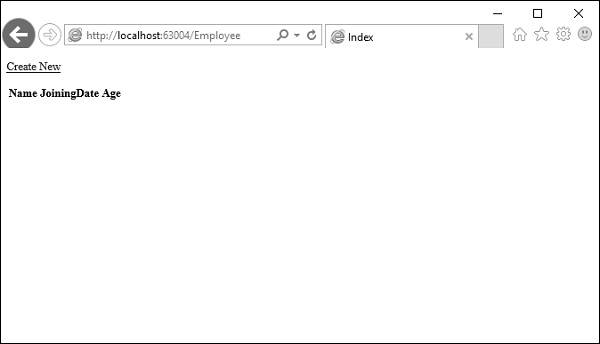
正如您所看到的,视图上没有数据,这是因为我们尚未在由 Visual Studio 创建的数据库中添加任何记录。
让我们转到 SQL Server 对象资源管理器,您将看到创建的数据库名称与 DBContext 类中的名称相同。

让我们扩展这个数据库,您将看到它有一个表,其中包含我们在 Employee 模型类中拥有的所有字段。
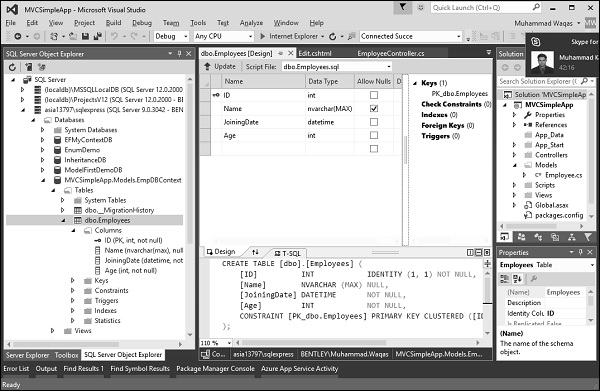
要查看此表中的数据,请右键单击"员工"表并选择"查看数据"。

您会看到我们目前没有记录。
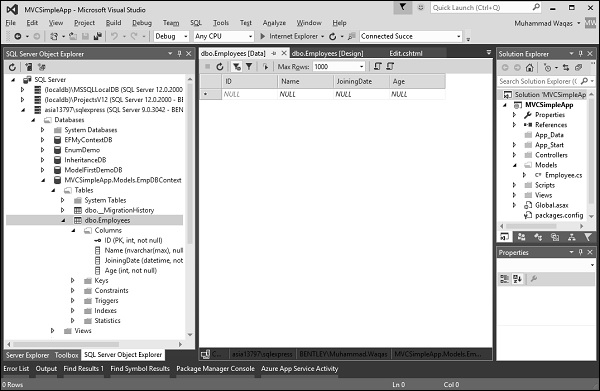
让我们直接在数据库中添加一些记录,如下图所示。

刷新浏览器,您将看到数据现已从数据库更新到视图。

让我们通过单击"新建"链接从浏览器添加一条记录。 它将显示"创建"视图。
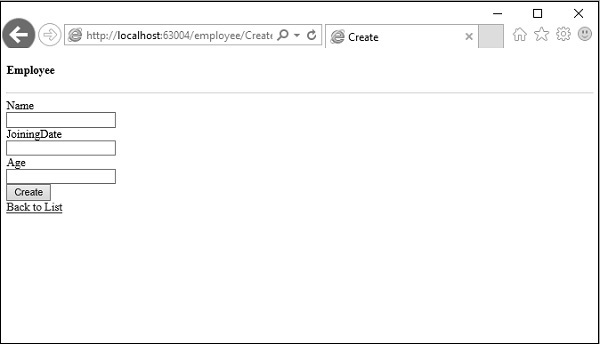
让我们在以下字段中添加一些数据。
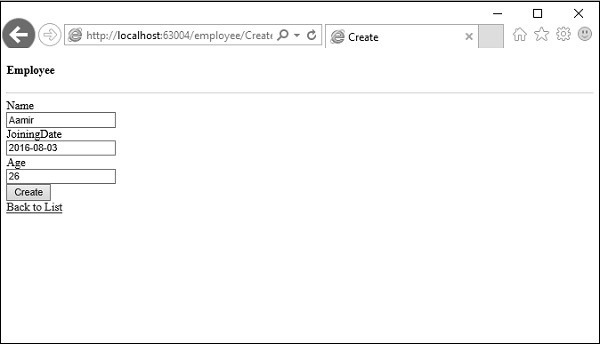
单击"创建"按钮,它将更新 Index 视图并将此新记录添加到数据库中。

现在让我们进入 SQL Server 对象资源管理器并刷新数据库。 右键单击"员工"表并选择"查看数据"菜单选项。 您将看到该记录已添加到数据库中。
